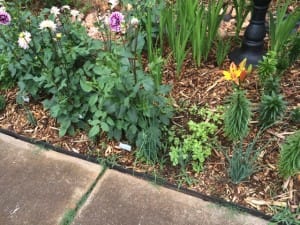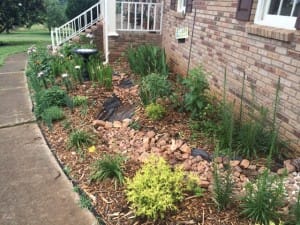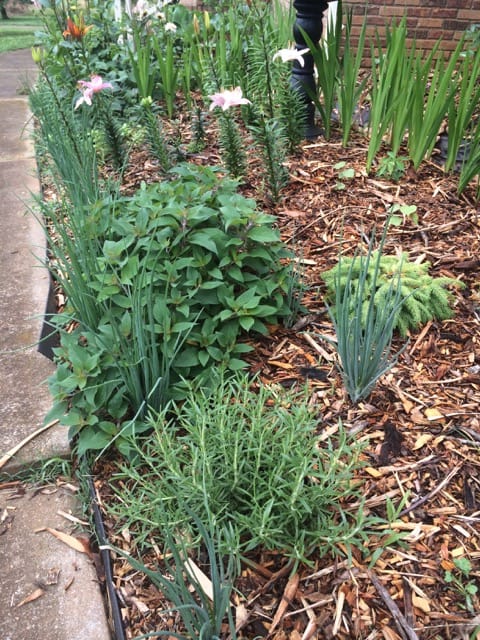Many of us have community areas of our gardens. Those spaces can give us an opportunity to show how people can incorporate food crops in a home landscape. This week our guest blogger, Joshua Fuder, gives us some ways to do this. Josh writes:
During a vacation in France last year I had an awakening of sorts in terms of my philosophy on garden design and plant selection. A number of the gardens and public parks that we visited incorporated vegetables like Swiss chard and kale in with annual flower plantings. As an avid gardener and even more avid eater I wondered why I wouldn’t incorporate more vegetables and herbs into more traditional ornamental plantings. I’ve always appreciated the beauty of the edible plants but never considered their value in an ornamental sense.
Gardeners in Georgia might consider incorporating edibles for a number of reasons:
- Sun Exposure-Ornamental beds are often the best or only location in homeowners yards that

Rosemary, sage, and shallots among evergreens and annuals. receive sufficient (at least 6 hours) sunlight for vegetables and herbs.
- Convenience-Ornamental plantings are often close to the areas of the yard that we use most so if your edibles are incorporated you may find using fresh ingredients easier. It is also easier to stay on top of weeds and insect issues if you are visiting the area more frequently.
- Reduced Grocery Costs – Many edibles, especially herbs can add to your monthly food bills if you buy from grocery stores.
- Improved Health – Fresh vegetables are a great source of vitamins and minerals when properly prepared and gardening can be great exercise.
The key to creating a visually appealing edible landscape is the artful combination of annuals and perennials. Most edibles are going to substitute for the use of annuals but there are some options for shrubs, vines, and small trees.

Annual Color: Rainbow chard, purple mustard, kale, lettuce can all add dramatic affect with their foliage and mid-rib color variation. Calendula and nasturtium are both edible flowers that can add color to salads and nasturtium leaves can be used in pesto. Basil comes in many varieties and colors, consider the dwarf boxwood variety to create more formal lines. Taller plants like corn, okra, and Jerusalem artichokes can be planted at the back of a garden to create height and screening.
Groundcover: Thyme, oregano, and savory make great evergreen ground covers. Goldberg Golden Purslane and New Zealand spinach (or tetragonia) have succulent leaves and a sprawling growth habit. Strawberries will also sprawl out and cover an area as well.
Shrubs and Perennials: Blueberries have become a major cash crop in Georgia but are beautiful plants that have spring flowers, summer fruit and fall color. Pomegranate, figs and jujubes are all great plants that grow well in our area. American Hazelnut is deciduous shrub/small tree that grows well in our area. Rosemary is a great addition with its evergreen, needle-like foliage. Garden sage is also evergreen and has a wonderful softness to its leaves like a ‘dusty miller’ or lambs ear.
Edible Vines and Climbers: Structures like arbors and trellises are a great way to add interest in your

garden and there are some great substitutions for the climbing rose or clematis you may have in mind. Muscadines are extremely hardy and have few problems compared to many of the bunch grapes. If you want an annual plant that is easier to control you can consider Malabar spinach which has delicious greens and beautiful red stems. There are all types of beans that will grow rapidly and cover a structure. The Chinese Red Noodle bean will produce one to three foot long burgundy beans that will amaze.
Trees: Apples are well suited for northern Georgia and can maximize a small space with a few espaliered trees. The serviceberry (juneberry) is a great alternative to a crapemyrtle and the birds will love it. Mulberries are delicious and very easy to grow, just make sure they are planted in an area where you won’t mind a mess. ‘Montmorency’ and ‘Balaton’ are varieties of Pie or ‘sour’ cherries that are great small trees that perform well in our area as well.
Joshua Fuder is a UGA Extension agent in Cherokee County, Georgia. Joshua has grown many different types of fruits and vegetables. He grew vanilla, coffee, pineapple, and black pepper while serving as a Peace Corps volunteer in Vanuatu (an island nation in the South Pacific).
Happy Gardening!
- ParSLAY the Day! - June 12, 2024
- 6th Annual Great Southeast Pollinator Census - May 28, 2024
- Are you ready for Pepper Palooza? - July 5, 2023

Great ideas! I could use the extra herbs and no reason not to plant them anywhere there is space!
Great article!
I have been thinking about adding some more “practical” plants to my yard, and you just gave me some good ideas.
I like to grow my own food to begin with, and this might take it to the next level, haha.